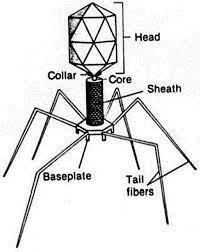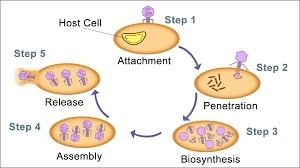Bacteriophage: characteristics and replication of lytic and lysogenic cycle
- Bacteriophages or simply phage are bacterial viruses that infects bacteria.
- Bacteriophages was first observed by Fredrick W. Twort in 1915.
- The term bacteriophage was used by Felix d’ Herelle in 1917.
Phage structure
- All phages have a nucleic acid core covered by a protein coat, called Capsid (subunits of capsids are called Capsomers).
- Several morphologically different types of phages have been discussed below:
-
- Polyhedral
- Filamentous
- Complex

- Complex phages have polyhedral heads with tails and with different types of appendages (tail plates, tail fibers etc.).
- An example of complex phage is phage T4.
- It has linear double-stranded DNA genome (172kb).
- Its genetic material is enclosed in a capsid and attached to a tail.
- It is an elongated icosahedron.
Phage T4 contains a very elaborate tale structure which includes:
- Head: contains nucleic acid and surrounded by Capsid.
- Collar: at the base of the head.
- Tail: a rigid Tail core surrounded by a contractile sheath.
- The core and sheath of phages are attached to a hexagonal base plate.
- Attached to the tail plate are tail pins and six – linked tail – fibers.
Phage genome
- Most of the phages are double-stranded DNA viruses.
Example:
| Nature of genome | Example |
| Single stranded DNA | Phi × 174 |
| Double stranded DNA | T-phages |
| Single stranded RNA | MS2 |
| Double stranded RNA | Phi 6 |
Replication
- All phages must carry out specific set of reaction in order to make more of themselves.
- There are two different types of viral replication or Life cycles:
-
- Virulent or Lytic cycle
- Temperate or avirulent or lysogenic cycle.
Lytic cycle
- Lytic cycle or vegetative life cycle causes the lysis or rupture of the host cell and release of large number of new viruses.
- Bacterial viruses exhibiting a lytic life cycle only are referred to as, Virulent bacteriophages because, it causes the death and destruction of the host bacterium.
- Examples T- even pages (T2, T4, T6).

The Lytic cycle consists of five steps:
-
- Attachment or adsorption
- Penetration or injection
- Synthesis or transcription
- Assembly
- Release or lysis
Adsorption or attachment
- The first step of lytic cycle is adsorption which involves the attachment of tip of the virus tail at the bacterial cell wall surface via specific receptor site.
- The specific receptor of the bacterium is lipopolysaccharide although any surface structure functions as phage receptor including Flagella, pilli and carbohydrates.
Penetration or injection
- The actual penetration of phage into the bacterial (host cell) is mechanical.
- But it may be facilitated by digestion of cell surface structure either by phage enzymes E.g. Lysozyme or by viral activation of host degradative enzymes.
- Penetration is achieved when:
- The tail fibers of virion attached to the cell and hold the tail firmly against the cell wall.
- The tail sheath, contract and driving the tail core into the cell through cell wall.
- The virus injects its genetic material into cytoplasm.
Synthesis
- Once the bacteriophage genome enters the cytoplasm, the phage DNA initiate synthesis of early proteins.
- Some early proteins break the bacterial DNA and take the control of the bacterial (host) cell machinery.
- The other early proteins serve as an enzyme for replication of phage DNA.
- The newly synthesized phage DNAs produce
- late proteins, that protein is used for phage capsid (head, tail and tail fibers).
Assembly
- After the synthesis, capsid protein assembles to form empty head, and viral DNA is packed inside it, results in the formation of numerous intact phage particles within cell.
Release or lysis
- After the assembly step is completed, viral proteins caused the lysis of host cell, and all the viral progeny are released into environment.
- The number of phage particles produces by every infected cell, known as the Burst size, and it is characteristics for each virus, ranges from 100 or more.

Lysogenic cycle
- In lysogeny, the viral DNA of the temperate phage, instead of taking control over the function of host cell machinery, it is incorporated into the host DNA and become prophage.
- A Cell that contain prophage called Lysogen.
- In this situation, the bacteria metabolize and reproduces normally, the viral DNA(genome) being transmitted to each daughter cell through all successive generation.
- Sometimes, when lysogenic bacteria are exposed to UV light or chemical, the viral DNA is removed from the host’s chromosomes and the lytic cycle occurs, this process is called spontaneous induction.
- Example of avirulent phages are lambda phages.
Reference and Sources
- 1% – https://www.biologydiscussion.com/science-fair-project/viruses-science-fair-project/science-fair-project-on-viruses/64803
- 2% – https://www.ncbi.nlm.nih.gov/books/NBK7908/
- 1% – https://www.researchgate.net/publication/269766865_Structure_ and_function_of_ bacteriophage_T4
- 1% – https://www.slideshare.net/DpuNotlari/chapter7-10448844
- 1% – https://www.ncbi.nlm.nih.gov/pmc/articles/PMC1924868/
- 1% – https://www.slideshare.net/utmang/bacteriophages-ppt
- 1% – https://www.mdpi.com/2076-0817/9/1/6/htm
- 1% – https://en.wikipedia.org/wiki/%CE%9B_phage
- 2% – https://study.com/academy/answer/describe-and-compare-the-lytic-and-lysogenic-multiplication-cycles-of-bacteriophage.html
- 1% – https://quizlet.com/93417688/ch-6-viruses-microbiology-flash-cards/
- 2% – https://biologywise.com/lytic-cycle-vs-lysogenic-cycle

Such an amazingg and useful page…..